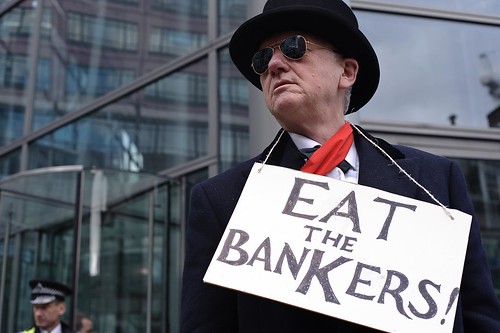
The furore over police attitudes to protesters and police during the G20 protests in London at the start of this month rages on, with clear sides beginning to emerge in the debate.
If the police had hoped the focus on their tactics would abate as the dust settled on the protests, the death of Ian Tomlinson and the almost daily emergence of videos showing the rough treatment of journalists and photographers has hasd the exact opposite effect.
Two journalists whose work documenting protest I highlighted here before the protests, photographer Marc Vallee and film-maker Jason N Parkinson, are at the forefront of the evidence-gathering.
Several of Parkinson's videos have been published by The Guardian online. While he put himself into the melee to document the protest, the strict policing meant he also came away with plenty of footage of police advancing on the assembled press, with occasionally violent results.
On his blog this weekend Parkinson wrote that he had suffered three days of concussion after being hit repeatedly over the head by baton-wielding police. He also claimed to have been jabbed in the kidney by a police medic.
The rest of the day panned out as most protest journalists imagined, hence many experienced photographers and video people using the now mandatory improvised safety equipment - helmets and arm and leg padding - something in itself that says a lot about policing these days. Others were not so ready for the brutal onslaught brought down into the streets by the infamous Metropolitan police force and the notorious black-clad, storm-trooper unit, the Territorial Support Group (TSG).
Writing on the Guardian's Comment is Free blog, Vallee points out that those journalists and photographers caught on the frontline were only doing what they felt was right and necessary:
At the same time it is important to note that many media workers, at some risk, went to work over these two days to document what was taking place. With the wholesale cutting of picture rates and jobs in the media due to the recession, the internet, mismanagement or in my view a mixture of all three, it was no surprise to me that the press were under huge pressure not only to come up with important and stunning pictures and footage but also to make sure this content got sold.
Theleft-leaning Guardian and its sister Sunday newspaper, the Observer, are natural homes for this kind of debate. But while those papers have led the reporting, the death of Ian Tomlinson catapulted the issue of police tactics onto a wider stage. Newspapers of all political stripes are now reporting and debating the issue.
Today's London Evening Standard quotes a former top Scotland Yard commander's withering view of modern polciing:
Officers are trained to be on guard against attack, to regard every situation, no matter how seemingly benign, as a threat situation. The lesson is that the public are your enemy. That mindset appeared to dominate the G20 protests.
And the conservative Daily Telegraph, no friend of protest movements, points to a key change in public attitudes in an editorial calling for a "new broom" at the Metropolitan Police:
Significantly, middle-class opinion now regards the police with intense suspicion. Most British citizens are law-abiding; but the middle classes break fewer laws than any social group and have traditionally reposed enormous trust in the country's police forces. Not any more.
Photographers and film-makers, by the very nature of their work, will more often than not find themselves caught in the middle of unfolding and unpredictable events in the years to come.
The ever-blurring lines between the "professional" and "amateur" photographer/journalist appears to be confusing the police, who are flailing and flapping much like newspaper owners seeking a revenue model in the internet age.
I admit it must be confusing, in the midst of an event, trying to distinguish between all those full-time pros and interested voyeurs.
Why doesn't someone draw up some guidelines, maybe invent a press card? Oh, hang on...
UPDATE: Great minds appear to think alike. Alastair Campbell has also found himself pondering this subject today, and makes a plea on his blog for balance in coverage of this issue. His point is fair and valid - the police are today's favoured targets. But I stick by my point - officers and commanders seem bewildered by the changes happening on the streets in front of them and how the nature of protest and media coverage is changing.

What do you think?